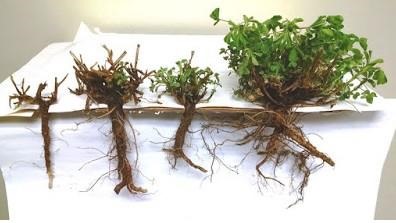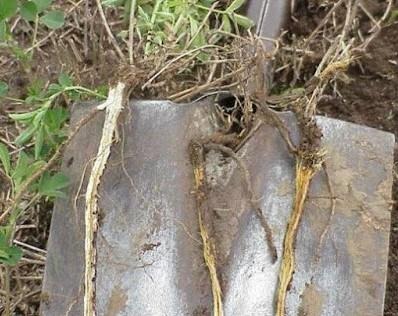By Nathan Drewitz
Despite some colder temperatures, alfalfa stands appear to be looking nice heading into May. However, there can be a difference between nice-looking fields and fields that will produce decent yields. This is why all stands need to be assessed each spring for winter injury; you want to make sure that winter injury issues aren’t going to surprise you. For stand assessments, you need to focus on two-parts: stem counts and root and crown health.
Stem counts
With stem counts, we usually measure this as stems per square foot. The relationship between stem density and yield is constant, making this method reliable in estimating yield. The steps of the procedure are as follows:
- Mark off a 2 square foot section in each area you take a count
- Count only those stems that are 2 inches or taller
- Divide your count by two and average across all sections
This will get you to the necessary stems per square foot needed to check yields. Typically, stem counts over 55 stems/sq. ft indicate a good stand. In that condition, we would expect you could lose some plants and still produce good yields. In contrast, with stem densities of 39 stems/sq. ft or less, we would expect yields in those stands to be low enough to consider replacing.
Make a visual assessment

Figure 1. Plants from left to right: 1) Dead plant with soft root,2) Asymmetrical growth, likely will not survive, 3) New spring
buds growing after winter injury. Plant will likely survive but
be slightly delayed, 4) Healthy plant with firm root
and vigorous growth. Photo courtesy of Dan Martens.
When visually assessing stands, start from the top of the plant and work your way down. Look for symmetry of bud growth; they should be coming from all sides of the crown.
Asymmetrical growth indicates that winter injury did occur and yield potential may be lower.
At this point, check to see if the root system is up out of the ground. Alfalfa taproots that have been pushed out of the ground by over an inch will most likely be short lived during the spring, provided they don’t break off.

Figure 2. A healthy alfalfa taproot on the left
and damaged taproots on the right.
Next, dig up plants from three or four representative locations in the field. Be sure to include at least the top 6 inches of the taproot for examination.
Cut the crown in half and examine the color and rigidity of the inside of the crown. You want to see a firm, off-white interior with little to no signs of rotting. Discolored and spongy crown interiors indicate rotting and a plant that may not live another year (Figure 2).
Keep or replace?
When making decisions on whether to keep or replace a stand, keep in mind both steps in the assessment. This is especially important with marginal stands, as stands with 40 stems/sq. ft may still yield well, provided plant health is good throughout the field. If the same stand contains plants with discolored crowns and asymmetric bud growth, that would indicate a potential yield reduction and the field may need to be replaced.
Source : umn.edu